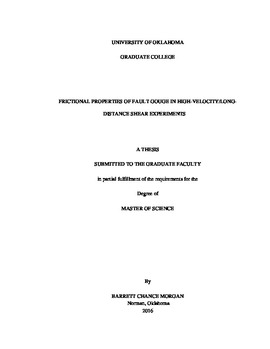| dc.description.abstract | The present objective is the characterization of the dynamic friction and seismic stability of fault gouge in high-velocity/long-distance shear experiments. The study has two parts based on the gouge source: A) Reservoir rocks and mixtures of quartz-calcite-clay to determine the effect of gouge composition on frictional properties; and B) gouge of the Alpine Fault zone, New Zealand, which is a major plate boundary in the later stage of the seismic cycle. Accordingly, the abstract includes two parts.
DYNAMIC FRICTION AS FUNCTION OF FAULT-GOUGE COMPOSITION
The seismic stability of a fault and its likelihood to generate earthquakes are controlled by its frictional properties (Brace and Byerlee, 1966). This project focuses on experimental characterization of the frictional properties of rocks and sediments. The results will contribute to a better understanding of the seismicity associated with hydrocarbon production and wastewater injection, which are known to trigger seismic slip on faults and fractures (Segall, 1989, Ellsworth, 2013).
The experimental analysis is based on shearing rock gouge samples at slip-velocities up to 0.5 m/s, which is comparable to seismic slip velocity. The samples were placed in a confined rotary cell, and were sheared as either room-dry or water-saturated. Two types of samples were used: (1) core samples from six oil reservoirs comprised of approximately equal amounts of quartz and clay, and calcite that varies between 10% and 90%; and (2) mixtures of quartz-calcite-clay grains that cover a wide range of sedimentary rock compositions. The core samples were ground into aggregates of 150-450 µm before testing. The 93 experiments were conducted at slip velocities of 0.001-0.5 m/s with either stepped-velocity or constant velocity to distances up to 15 m.
The main results are: (1) the friction coefficient ranges widely from very low (~ 0.1) to very high (~1.2) with low strength of the water saturated samples, and weakening intensity proportional to the relative abundance of calcite in the samples; (2) The velocity-dependence of friction showed complex trends of velocity-weakening, velocity-strengthening, or velocity-neutral behavior.
DYNAMIC STRENGTH OF ALPINE FAULT GOUGE
The Alpine Fault, New Zealand, is a large plate boundary fault with slip rate of ~ 37 mm/y, and a documented history of M~8 seismic events (Sutherland, 2007). Trench analyses have shown that slip frequently ruptures to the surface, and suggest that a large earthquake occurs approximately every 300 years (Wells et al., 1999; Berryman, 2012). As the last known event occurred in 1717, the Alpine Fault is late in the seismic cycle (Sutherland, 2007).
To better understand the slip behavior and related hazards of the Alpine Fault, we analyze the frictional properties of its gouge that was collected at three field exposures (Waikukupa, Cataclasite, and Gaunt) along 40 km stretch of the Alpine Fault. The bulk samples (1-3 kg) were first manually disintegrated without shear, and then sieved to the 250-350 µm fractions. The gouge was sheared at natural, moisture-rich conditions at slip-velocity range of 0.01-1.5 m/s in stepped-velocity style with a constant normal stress of ~3 MPa. Data collection included monitoring the CO2 and H2O emission, in addition to the standard mechanical parameters.
The results show an initial friction coefficient of µ ~0.6. Initial slip at low velocities (0.01 m/s) displays gentle velocity strengthening that changed to a drastic weakening (~50%) at velocity of 0.5 m/s. This weakening was associated with intense slip localization along a hard, dark slip surface within the gouge zone. After the establishment of this slip surface, there was no strength recovery and the sample remains weakened. If such behavior occurs during a natural earthquake, it will allow the release of a significant amount of the accumulated energy, which may result in a stronger earthquake with larger displacement. | en_US |
